Introduction
Green mussel (Perna viridis) is a commercially significant commodity in the Philippines.1 Its latest production had amounted to 18,800 metric tons and considered as top-six among commercially aquaculture species in our country. The major mussel producing provinces include Cavite, Capiz, Samar, Bataan, and Negros Occidental.2 The species is favored as part of the human diet due to its high levels of vitamins and minerals.3,4 The mussel has served as an alternative cheap protein source for coastal communities.5
Bivalves have a short shelf life after harvest due to their neutral pH, high amino acid and water activity that favors microbial spoilage. Its high initial microbial load due to their filter-feeding nature further contributes to its shorter shelf life.6 The green mussel can be kept alive for 36-48 hours after harvest at ambient temperature.7 This period is not enough to transport green mussels in distant mussel farms to markets.
The development of processing methods to increase the shelf life of mollusc is important.8 Packaging can enhance the quality preservation of food products.9 Appropriate packaging together with refrigeration plays an effective role in maintaining the quality of fish and other fishery products.10,11 Pre-treatment process is also necessary to increase shelf life and quality of fishery products.12 Dipping in organic acids are popular food treatments in the industry because of their natural occurrence in various vegetables and animal substrate.13 Lactic and citric acids are generally recognized as safe (GRAS) and are beneficial in extending the shelf life of meat products subjected to cold storage.14 Two percent lactic and acetic acids were found effective in reducing the occurrence of pathogens (S. Typhimurium and E. coli O157: H7) in food.15 However, drawbacks for acid utilization include high exudates and cooking loss.5 Sodium tripolyphosphate (STPP), another commonly used additive in the preservation of meat and fishery products helps address textural problems in cold storage.16,17 This compound is legally utilized and permitted for improving the eating quality of many foods, particularly meat and fish.18 It can effectively control drip loss and cooking loss of pre-treated food products,19 inhibit bacterial growth in fishery products stored in ice and retard oxidation of unsaturated fatty acids in seafood.20 A study on the utilization of combined citric acid and STPP had been utilized to increase product yield and improve texture quality.21 The possible potential of organic acids and STPP together is seen to increase shelf life and improve the quality of chilled seafood products but there were no studies done specifically on the mussel. Thus, this study assessed the effects of pre-treatments using lactic acid, citric acid, STPP and their combinations on the quality of vacuum-packed green mussels during chilled storage. The percent concentration was used for a possible better-quality preservation and longer shelf life for the product.
Materials and Methods
Collection and preparation of mussel samples
The green mussel was freshly harvested from Taytay, Palawan, Philippines. Samples were declustered at harvest area and packed in an insulated box added with ice following the 5:1 mussel/ice ratio (w/w)22. The samples were transported to Iloilo, Philippines via airfreight and immediately brought to the University of the Philippines Visayas Fish Processing Laboratory with 7 hours of travel time from the harvest site. The mussels were washed with tapped water to remove adhering dirt. Samples were sorted to remove dead mussels that exhibit foul odor and gaping.
Green mussels were subjected to blanching at 85˚C for 2 mins using a 1:5 mussel/water ratio (w/v). Then, the blanched mussel was submerged in iced water for immediate cooling. Three kilos of mussel meat per group were utilized for pre-treatment. Organic acid concentrations used were 2% (w/v) with 5 minutes soaking time and sodium tripolyphosphate concentration was 10% (w/v) using 1-minute soaking time. The following were the different pretreatments used for this study and all were individually dissolved in distilled water: 2% lactic acid (LA), 2% citric acid (CA), 10% sodium tripolyphosphate (STPP), 10% STPP + 2% lactic acid (STPP-LA), 10% STPP + 2% citric acid (STPP-CA) solutions. The pretreatments with the combination also utilized distilled water for rinsing of samples with 5 minutes draining time. All samples were packed using Nylon PE bags (6in. x 10in. x 75 microns) and sealed. The storage condition of the pretreated green mussel was 3˚C±1˚C for 24 days and the analyses were performed every 3days (Figure 1).
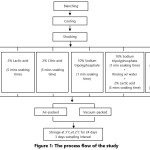 |
Figure 1: The process flow of the study. Click here to View figure |
Evaluation of sensory qualities
Samples were wrapped in aluminum foil and steamed for 18 minutes in boiling water. Sensory assessment of organic acid pretreated and control samples were done by a descriptive and acceptability test using a line-scale method23,24 Ten semi-trained panelists were asked to assess the odor (seaweedy and ammoniacal), flavor (naturally sweet and sour) and acceptability (odor, flavor, and general) of green mussels. The descriptive ratings of the different attributes were as follows: seaweedy odor, 10=pronounced, 1=absent; ammoniacal odor, 10=pronounced, 1=absent; natural sweet flavor, 10=intense, 1=absent; sourness, 10=pronounced, 1=absent; and acceptability, 10=like extremely, 1=dislike extremely. Before evaluation, tests and parameters were explained to panelists. They were instructed not to eat the mussels during the sensory evaluation. Water and unsalted crackers were provided as taste neutralizer.
Microbiological Evaluation
The spread plating method was followed for the estimation of the microbial population in the green mussel samples. About 10 g of sample was weighed under sterile conditions and homogenized with 90 ml of 0.01% peptone water. After tenfold serial dilution, the diluted samples were spread onto agar. Lactic acid bacteria were determined on MRS agar, incubated for 48 h at 37˚C25. The psychrophilic bacteria were enumerated on plate count agar and incubated for 5 days at 8˚C26. The results were expressed in terms of log colony-forming unit (log CFU) per g of mussel sample.
Physico-Chemical Analyses
Determination of pH
The pH value of green mussel with and without acid pre-treatment was prepared27 and determined using pen-type pH meter.
Determination of weight loss
For weight loss analysis, green mussel was weighed per treatment, packed and subjected to chilled storage. The pre-weighed samples were withdrawn and weighed again every sampling interval. Separate packs of the sample were prepared for every sampling period. The weight loss was determined using the following formula28:
Weight loss (%) = B/A x 100 (where: A were the initial weight and B as the final weight)
Determination of volatile compounds
The extraction and analysis of volatile compounds including total volatile basic nitrogen (TVBN) and trimethylamine nitrogen (TMAN) were carried out according to the Conway method29. The results for both volatile compounds were expressed as mg N/100g.
Determination of Ammonia
The ammonia content of pretreated and untreated green mussel was measured according to the Indophenol method.30 The result was expressed as mg/kg muscle.
Statistical Analysis
The results were analyzed using one-way ANOVA and the mean was statistically evaluated using Duncan’s multiple range test (DMRT) with the level of significance set at P<0.05. All the statistical analyses were carried out using the SPSS (version 20) software (SPSS Inc., Chicago, Illinois).
Results and Discussion
Sensory Attributes and Acceptability of Chilled Green Mussel
This study assessed the organoleptic changes in chilled mussel pre-treated with organic acids and sodium tripolyphosphate using a descriptive and acceptability test. Figure 2 shows the sensory attribute of green mussel pre-treated with the organic acid and STPP in vacuum-packed chilled for 24 days at 3˚±1˚C. The score for seaweedy odor declined with storage. Control in air-packed had the highest mean value of 7.79±1.32 for seaweedy odor on day 3. But both control samples in the air- and vacuum-packed together with STPP pre-treated mussel in vacuum-packed were rejected on the 9th day of storage. Lactic acid pre-treatment effectively maintained the seaweedy odor compared to other treatments.
Ammonia is an end product produced during the degradation of urea and other nitrogenous compounds by the action of microorganism.31 The high score indicates the detection of ammoniacal odor. STPP-LA had the lowest score for ammoniacal odor at the start of storage compared with other samples but it increased with storage. STPP prevented the formation of ammoniacal odor on early days of storage but not in the later period which resulted in the product getting rejected after day 6. Lactic pre-treatment of green mussel in vacuum-packed slowed down the formation of distinct ammoniacal odor in day 9 until the end of the 24th day of chilled storage.
The natural sweet flavor of mussel was retained by the control sample in air-packed until the 2nd sampling days of chilled storage. A significant reduction in the natural sweet flavor was noticed in the acid treated samples, probably due to the masking effect of sour flavor on the samples. Overall, the natural sweet flavor of the samples declined with storage. In postharvest shellfish, the initial breakdown of ATP results in the accumulation of inosine monophosphate that contributes to pleasant flavor. But subsequent breakdown results in loss of flavor.32
Sourness attribute was included in the test to check whether acid pre-treatment will result in the significant souring of the product and to test the consumer’s acceptance of the acid. The significantly high score indicates that acid pre-treatment contributes to a noticeable product souring. Significant differences were observed between control and pre-treated samples.
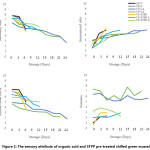 |
Figure 2: The sensory attribute of organic acid and STPP pre-treated chilled green mussel. Click here to View figure |
(C) control; (LA) lactic acid; (CA) citric acid; (STPP) sodium tripolyphosphate; (STPP-LA) sodium tripolyphosphate with lactic acid; (STPP-CA) sodium tripolyphosphate with citric acid. Values are presented as mean±standard deviation of three determinations; means with different letters in the same row are significantly (p <0.05) different from each other per sampling day.
Figure 3 indicates the sensory acceptability of chilled green mussel pre-treated with organic acids and STPP. Control samples in the air- and vacuum-packed had a significant mean score (8.03) for odor at the start of the storage. Vacuum-packed CA, STPP-LA, and STPP-CA have a high score of acceptability until the 3rd sampling day of storage after which an abrupt decline in odor scores was observed. This indicates that vacuum-packaging can effectively preserve the desirable odor of mussel at the initial week of storage and decline its scores which is an indication of product spoilage and may be attributed to ammonia formation.
Control in an air- and vacuum-packed had significant high flavor acceptability on day 0 (P<0.05). STPP and its combination with citric acid and lactic acid had effectively preserved the attributes of mussel flavor, thus the score attained for STPP-acids were higher than control and acid alone.
In summary, a decrease in the quality and acceptability of the samples was observed with storage. STPP had the beneficial effect of maintaining and preserving the sensory attributes of chilled green mussels but was not effective for longer storage as shown by the early rejection of samples. Lactic acid pre-treatment enhanced the shelf life and was effective in retarding off-odor development until the 24th day of storage compared to the untreated sample with 6 days of shelf life. The off-odor (i.e., ammoniacal) development contributed largely to product rejection in the control and STPP-treated samples.
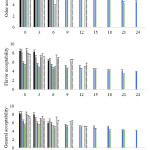 |
Figure 3: Acceptability of chilled green mussels. Score: 10=like extremely, 1=dislike extremely. Click here to View figure |
Microbiological Changes of Chilled Green Mussel
Microbiological analysis of spoilage organisms is necessary to determine the quality and safety of foods.4 Microbial load determined in this study includes lactic acid bacteria count and psychrophilic bacteria count in chilled mussel stored for 24 days (Figure 4). The anoxic environment prevents microbial growth and delays spoilage due to the slow proliferation of bacteria capable of tolerating anaerobic conditions.33 Lactic acid bacteria are the group of spoilage organisms known to dominate vacuum-packed foods due to their ability to grow rapidly under anaerobic conditions at low temperatures; they can tolerate carbon dioxide in the environment.4 The acceptable limit for lactic acid bacteria used in most storage studies of the mussel is 7 log CFU/ g.34 Results obtained from this study show that the lactic and citric acid-treated samples had lower initial bacterial count than other pre-treated samples. Organic acid pretreatment resulted in lower bacterial count throughout storage relative to STPP treated and control samples. Antimicrobial property of weak acids including lactic and citric acid is related to the concentration of their undissociated acids (pKa). Lactic acid with higher pKa value has higher antimicrobial property than acids with lower pKa like citric acid. Lactic acid can pass through the cell membrane and dissociate once inside the cell and acidify the internal pH and prevent the growth of microorganism.35
Lactic and citric acid pre-treated meat effectively reduced its growth compared to control and STPP-treated samples. A safety limit of 6 log CFU/g36 was reached at 15 days of storage in the control, STPP, and STPP-acid treated samples while CA and LA samples remained safe until 18 and 21 days of storage, effectively.
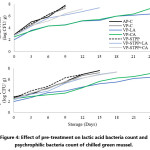 |
Figure 4: Effect of pre-treatment on lactic acid bacteria count and psychrophilic bacteria count of chilled green mussel. Click here to View figure |
Studies suggested that mackerel and anchovy having a psychrophilic microbial of 6 log CFU/g was acceptable,36 thus, it was used as the basis for this study. Psychrophilic bacteria count of organic acid treated samples was lower than STPP and untreated samples.
Physico-Chemical Changes of Chilled Green Mussel
pH values are frequently used as the physical quality control for fish, seafood and fish products and are always assessed together with TVB-N, TMA-N, and TBARS for seafood quality assessment.37 It can be used as an indicator of postmortem change of glycogen to lactic acid and the degradation of muscle components during long storage.38 Control samples had near-neutral pH value at the start of storage study and declined with storage. Pre-treatment using lactic and citric acids resulted in medium acidification (4.3-4.6) of the samples, with values significantly lower than the control (P<0.05) (Figure not included).
The loss of water directly explains the loss of mass in meats and substantial yield loss in the manufacturing process.39 Weight loss in vacuum-packed control (Figure 5) was significantly lower compared to air-packed control and vacuum-packed acid pretreated samples (P<0.05).
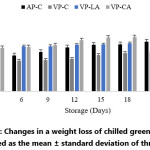 |
Figure 5: Changes in a weight loss of chilled green mussel. Values are presented as the mean ± standard deviation of three determinations. Click here to View figure |
Total volatile basic amines (TVB) are widely used to assess seafood quality and comprised the measurement of trimethylamine (by spoilage organism), dimethylamine (by autolytic enzyme in frozen storage), ammonia (by the deamination of amino acids and nucleotide catabolites) and other volatile basic nitrogenous compound present in fish and fishery products.40,41 It is the product of bacterial spoilage commonly used in the assessment of the freshness index of seafood products.5,42 Spoilage pattern in fresh seafood is generally depicted by the increase in TVB-N concentration that is related to bacterial proliferation.43,44 Figure 6 shows the TVB-N content of chilled green mussel pre-treated with organic acids. Total volatile basic nitrogen of chilled green mussel was lower in organic acid pre-treated green mussel than control samples. The lactic acid in vacuum-packed has the lowest TVB-N values during the entire storage (P<0.05). The acceptable safety limit for TVB-N in fish muscle is 35 mg N/ 100g; beyond this value, fish is considered spoiled.42,45 The control samples in the air- and vacuum-packed reached safety limit at days 15 and 18 of storage, respectively.
Trimethylamine nitrogen (TMA-N) is another spoilage product commonly used in measuring freshness in marine fishes.41,46 The results obtained were similar to TVB-N wherein acid treated green mussels attained the increase significantly lower values compared to the untreated samples. TMA-N value among fish species is around 10-15 mg TMA-N/ 100g fish which is then determined the acceptable limit for human consumption.41 The suggested limit for TMA-N of the mussel is 3 mg N/ 100g.47 Vacuum-packed green mussel pre-treated with lactic acid had attained significantly lower values than the untreated samples (P<0.05).
Ammonia present in post-mortem flesh is derived from the deamination of adenine nucleotides to inosine monophosphate that is known to occur rapidly during harvesting and death of the fish or within few hours after storage in ice. Its increasing level reflects the decomposition of muscle in food products.48 Ammonia concentration of vacuum-packed chilled green mussel pre-treated with lactic acid attained significantly lower values compared to untreated samples (P<0.05). Both air- and vacuum-packed control samples reached the safety limit for ammonia after 9 days of storage while vacuum-packed lactic acid pre-treated samples attained the safety limit on day 24.
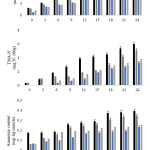 |
Figure 6: Effect of organic acid pre-treatment in volatile compounds and ammonia content of chilled green mussel. Click here to View figure |
Conclusions
Lactic acid pre-treatment was the most effective method in preserving the quality of chilled mussel. The product can remain acceptable up to 24 days of chilled storage when done in combination with vacuum packaging. Citric acid pre-treatment in combination with vacuum packaging may also be used in the absence of lactic acid since it can extend product shelf life for up to 21 days compared to the non-treated samples which only lasted for 6 days. Although STPP effectively protected product textural integrity and prevented drying and weight loss, it was not effective in retarding microbial growth which may have contributed to faster product quality deterioration. The vacuum-packed STPP treated mussel had the shortest shelf life of only 6 days. The combination of treatments was not also effective in extending the quality and shelf life because they only lasted for 12 days of storage.
Thus, lactic acid can be effectively applied to the food industry particularly in primary processing of shellfish like green mussels to extend shelf life and preserve quality up to 24 days of chilled storage.
Acknowledgments
The researchers acknowledged the support of the University of the Philippines Visayas-College of Fisheries and Marine Sciences for providing the facilities for this study.
Funding
The study was funded by the Department of Science and Technology-Accelerated Science and Technology Human Resources Development Program (DOST-ASTHRDP) and Department of Science and Technology-Philippine Council for Agriculture, Aquatic, and Natural Resources Research and Development (DOST-PCAARD) Mussel Program.
Conflict of interest
The authors declare no conflict of interest.
References
- Yap, W. Rural Aquaculture in the Philippines. Regional Office for Asia and the Pacific- Food and Agriculture Organization of the United Nations. 1999: 1-60.
- Philippine Statistics Authority (PSA). Fisheries Situationer. PSA-Department of Agriculture. 2015: 1- 28.
- Vareltzis, K. Mussels as food. Fish News. 1996; 11: 38- 47.
- Caglak, E., Cakli, S., Kilinc, B. Microbiological, chemical and sensory assessment of mussels (Mytilusgalloprovincialis) stored under modified atmosphere packaging. European Food Research Technology. 2008; 226: 1293- 1299.
- Masniyom, P., Benjama, O. Effect of lactic, acetic and citric acids on quality changes of refrigerated Green Mussel Pernaviridis (Linnaeus, 1758). Songklanakarin Journal of Science and Technology. 2007; 29(4): 1123-1134.
- Batista, I., Mendes, R. Processing mollusc, shellfish and cephalopods. In: Second international congress on seafood technology on sustainable, innovative and healthy seafood. Food and Agriculture Organization Fisheries and Aquaculture Proceedings. 2012; 85-108.
- Lima, M.,Siga, M.,Leitempergher, F.,Lerin, L., Soares, L.,Tosati, J., Rodrigues, N., Monteiro, A. Mussel (Pernaperna) processing by an alternative method and packaging under modified atmosphere to improve physicochemical and microbiological characteristics. Journal of Food Processing and Preservation. 2016; 1-9.
- Tribuzi, G.,De Agarao, G., Laurindo, J. Processing of chopped mussel meat in retort pouch. Food Science and Technology. 2015; 35(4): 612-619.
- Sahoo, J., Kumar, N. Quality of vacuum packaged muscle foods stored under frozen conditions: A review. Journal of Food Science and Technology. 2005; 42: 209-213.
- Kim, C., Hearnsberger, J., Vickery, A., White, C., Marshall, D. Extending shelf life of refrigerated catfish fillets using sodium acetate and monopotassium phosphate. Journal of Food Protection. 1995; 58: 644–647.
- Jayasingh, P., Cornforth, D., Carpenter, C., Whittier, D. Evaluation of carbon monoxide treatment in modified atmosphere packaging or vacuum packaging to increase color stability of fresh beef. Meat Science. 2001; 59:317-324.
- Rostamzad, H., Shabanpour, B.,Shabani, A.,Shahiri, H. Enhancement of the storage quality of frozen persian sturgeon fillets by using ascorbic acid. International Food Research Journal. 2011; 18: 109- 116.
- Gomis, D. B. HPLC Analysis of Organic Acids. Food Analysis by HPLC. New York: Marcel Dekker. 1992; 371-385.
- Whittle, K. J., Hardy, R., Hobbs, G. Chilled fish and fishery products. In: Chilled Foods:The State of the Art. Elsevier Applied Science. 1990; 87- 116.
- Harris, K., Miller, M.,Loneragan, G.,Brashears, M. Validation of the use of organic acids and acidified sodium chlorite to reduce Escherichia coli O157:H7 and Salmonella typhimurium in beef trim and ground beef in a simulated processing environment. Journal of food protection.2006; 69: 1802- 1807.
- Food and Drug Administration (FDA). Is something fishy going on? FDA Consumer Magazine.1993; 1-10.
- Goncalves, A., Ribeiro, J. Do phosphate improve the seafood quality. Reality and Legislation. Pan-American Journal of Aquatic Sciences. 2008; 3(3): 237-247.
- Aitken, A. Polyphosphate in fish processing. Torry Advisory Notes. Torry Research Station- Food and Agriculture Organization (FAO). 2001; 31:1-4.
- Rippen, T., Sutton, H., Lacey, P., Lane, R., Fisher, R.,Dupaul, W. Functional, microbial and sensory changes in ice- stored sea scallops (Placopectenmagellanicus) treated with sodium tripolyphosphate. Journal of Muscle Foods. 1996; 7: 93- 108.
- Masniyom, P., Benjakul, S.,Visessanguan, W. Combination effects of phosphate and modified atmosphere on quality and shelf life extension of refrigerated seabass slices. Lebensmittel-Wissenchaft&Technologie. 2005; 38: 745-756
- Roman, M. T. Yield and quality of meat from shrimp (Pandalusjordani) pre-cooked in water containing condensed phosphate (Master’s Thesis): Oregon: Oregon State University. 1979.
- Arcales, J., Nacional, L. Effect of lactic and citric acid pretreatment on quality changes of green mussel (Pernaviridis) during chilled storage. Current Research in Nutrition and Food Science. 2018; 6(3): 862-870.
- Wolters, C. Effect of training procedure on the performance of descriptive panels. Food Quality and Preference. 1994; 5: 203-214.
- Peyvieux, C., Dijksterhuis, G. Training a sensory panel for TI: A case study. Food Quality and Preference. 2001; 12: 19-28.
- Hur, S., Jin, S., Park, J., Jung, S., Lyn, H. Effect of modified atmosphere packaging on quality characteristic of low grade beef during cold storage. Asian Australias Journal of Animal Science. 2013; 26(12): 1781- 1789.
- Greene, V. Influence of temperature history in response of psychrophiles to different incubation temperatures. Journal of Dairy Science. 1959; 42: 1097-1098.
- Woyewoda, A., Shaw, S., Ke, P., Burns, B. Recommended laboratory methods for assessment of fish quality. Canadian Technical Report of Fisheries and Aquatic Sciences. 1986; 1448: 2-4.
- Pastoriza, L., Sampedro, G., Herrera, J., Cabo, M. Effects of modified atmosphere packaging on shelf life of iced fresh hake slices. Journal of Science Food Agriculture.1996; 71: 541- 547.
- Conway, E. T. Micro diffusion and volumetric error. London Crosby Lockwood and Son Ltd. 1950.
- Scheiner, D. Determination of ammonia and kjeldahl nitrogen by indophenols method. Water Research Journal. 1976; 10: 31-36.
- Ryer-Powder. J. E. Health effects of ammonia. Plant/ operation Progress. 1991; 10(4): 228-232.
- Ashie, I., Smith, J., Simpson, B. Spoilage and shelf life extension of fresh fish and shellfish. Critical Reviews in Food Science and Nutrition. 1996; 36(1): 87-121.
- Goulas, A., Chouliara, I.,Nessi, E.,Kontominas, M.,Savvaidis, I. Microbiological, biochemical and sensory assessment of mussels (Mytilusgalloproviancilis) stored under modified atmosphere packaging. Journal of AppliedMicrobiology. 2005; 98: 752- 760.
- International Commission on Microbiological Specifications for Foods (ICMSF). Microorganism in Foods. Sampling for Microbiological Analysis: Principles and Scientific Applications. 1986; 2(2): 181- 196.
- Giannuzzi, L., Zaritzky, N. Effect of ascorbic acid in comparison to citric and lactic acid in Listeria monocytogenes inhibition at refrigeration temperatures.Lebensmittel-Wissenchaft&Technologie – Food Science and Technology. 1996; 29: 278-285.
- Mol, S.,Erkan, N.,Ucok, D.,Tosun, S. Effects of psychrophilic bacteria to estimate fish quality. Journal of Muscle Foods. 2006; 18: 120-128.
- Terzi, G.,Gucukoglu, A.,Cadirci, O.,Kevenk, T.,Alisarli, M. Effects of chitosan and lactic acid immersion on the mussel’s quality changes during the refrigerated storage. Research Gate. 2012; 1-8.
- Songsaeng, S., Sophanodora, P.,Kaewsrithong, J.,Oshima, T. Quality changes in oyster (Crassotreabelcheri) during frozen storage as affected by freezing and antioxidant. Food Chemistry. 2010; 123: 286-290.
- Almonacid, S., Bustamante, J., Simpson, R.,Urtubia, A., Pinto, M., Teixeira, A. Commercially sterilized mussel meats (Mytilus chilensis): A study on process yield. Journal of Food Science. 2012; 77(6): 127.
- Huss, H. Quality and quality changes in fresh fish. FAO Fisheries Technical Paper. 1995; (348):195.
- Turan, H., Sonmez, G.,Celik, M.,Yalcin, M., Kaya, Y. Effect of different salting process on the storage quality of mediterranean mussel (Mytilusgalloprovincialis 1819). Journal of Muscle Foods. 2006; 18: 380- 390.
- Connell, J. Methods of Assessing and Selecting for Quality. In: Control of Fish Quality. Fishing New Book. 1990; 3: 122- 150.
- Mitsubayashi, K., Kubotera, Y., Yano, K., Hashimoto, Y., Kon, T.,Nakakura, S. Trimethylamine biosensor with flavin- containing monooxygenase type 3 (FMO3) for fish-freshness analysis. Sensors and Actuators B: Chemical. 2004; 103: 463–467.
- Siripatrawan, U., Sanguandeekul, R.,Narakaew, V. An alternative freshness index method for modified atmosphere packaged abalone using artificial neural network. Lebensmittel-Wissenchaft&Technologie -Food Science and Technology. 2009; 42: 343- 349.
- Commission Decision. Total Volatile Basic Nitrogen (TVB-N) limit values for certain categories of fishery products and specifying the analysis method to be used. Journal of European Communities. 1995; 97: 84- 87.
- Gokoglu, N., Ozkan, O., Erkan, N. Physical, chemical and sensory analyses of freshly harvested sardines (Sardina pilchardus) stored at 4˚C. Aquatic Food Production Technology. 1998; 7(2): 5- 15.
- Erkan, N. Changes in quality characteristics during cold storage of shucked mussels and selected chemical decomposition indicators. Journal of Science Food and Agriculture. 2005; 85: 2625- 2630.
- Huang, Y., Kouadio, K., Gates, K. Effect of packaging on chemical changes and quality of refrigerated spot (Leiostomusxanthurus). Journal of Aquatic Food Production Technology. 1992; 2: 111- 127.

This work is licensed under a Creative Commons Attribution 4.0 International License.






